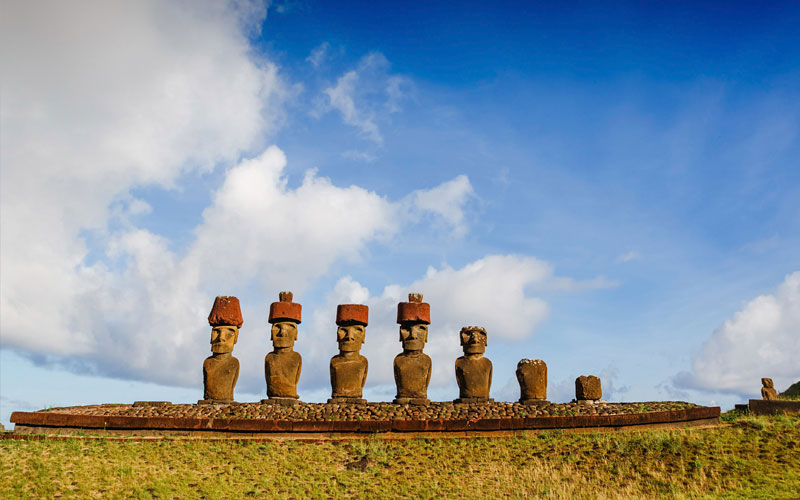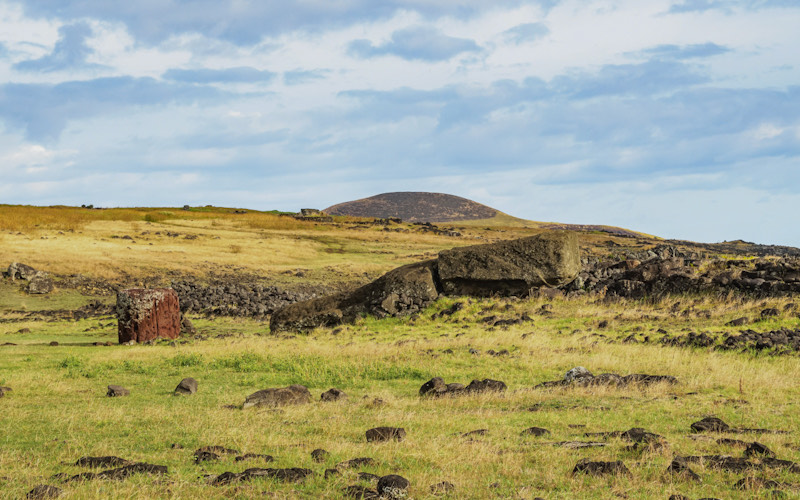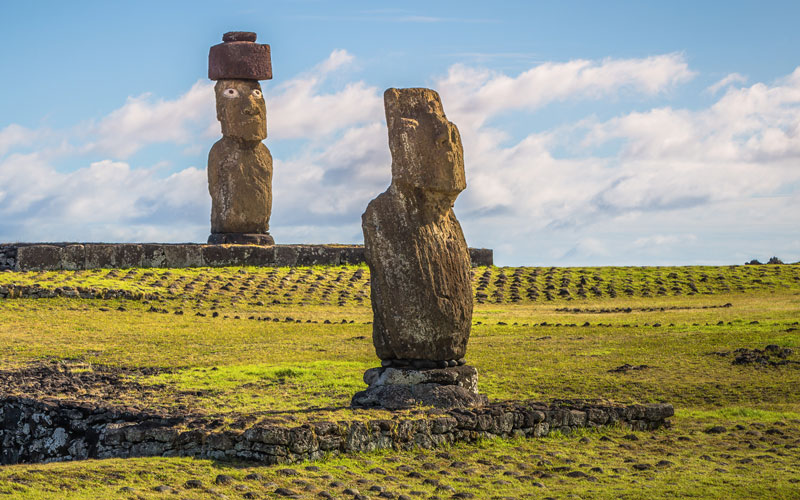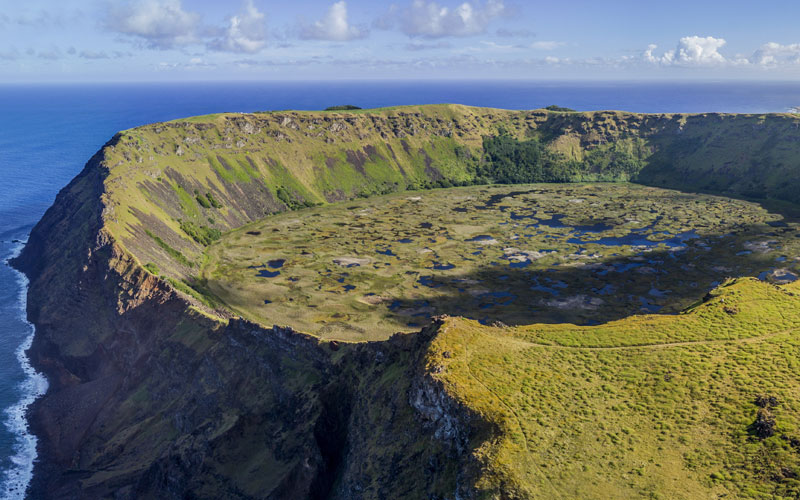Hotel pick up & drop off
Private transportation
Private tour guide (Bilingual Spanish/English)
Bottled water
Experience the best of Rapa Nui at your own pace with our Two Day Tour. On Day 1, delve into the island's stunning natural landscapes and intriguing cultural heritage. Begin at Anakena, a pristine beach boasting finely crafted moai statues at Ahu Nau Nau. Next, visit Te Pito Kura and the ancient Puna Pau quarry, where you can witness the red scoria that was once used to create the moai's ātopknots.ā Continue to Ahu Akivi, where the seven moai statues stand gaze towards the sea. Explore the picturesque Ahu Tahai and admire the captivating ocean views from Rano Kau before venturing to the ancient ceremonial village of Orongo.
On Day 2, discover lesser-known destinations with extraordinary landscapes and intriguing history. Unravel mysteries at Vinapu, where remarkable stonework similar to the Incas' can be found.
Admire the unique moai statue at Moai A Umi, and relish the breathtaking sights at Hanga Poukura. Prepare to be fascinated by the fallen moai statues at Vaihu and Akahanga, before visiting the Rano Raraku quarry, the birthplace of the moai.
Finally, the tour culminates at the majestic Ahu Tongariki, where 15 restored moai statues stand tall in perfect alignment.
This exclusive tour offers the flexibility to explore the island's captivating highlights in a more personal and fulfilling way, making it the ideal choice for those seeking to uncover the full extent of Rapa Nui's wonders. Join us on this unforgettable journey and let the island's magic captivate your heart and mind.
ANAKENA BEACH
Rapa Nui, Chile
Anakena Beach is revered as the historical and cultural cradle of Easter Island. Legend has it that the first king, Hotu Matu'a, landed here, establishing the initial settlement of Rapa Nui culture. Initially named Hanga Mori or One, it was later dubbed Anakena after a nearby cave. This beach evolved into a significant population center and a crucial site for the Miru tribe. Anakena boasts vital archaeological remains dating back to 1200 AD, including ceremonial centers, residential areas, and Ahus (ceremonial platforms). Notable among these are Ahu Ature Huki, featuring a single moai, and the impressive Ahu Nau Nau, adorned with seven finely detailed Moai. The latter, restored in 1978, is a remarkably preserved complex, as its Moai were protected from weathering by being buried in sand.
TE PITO KURA
Rapa Nui, Chile
Te Pito Kura is home to the impressive Paro moai, the largest statue ever erected on an Ahu. The Moai, standing at 10 meters tall and weighing over 80 tons, remains in the same position as it was left when it collapsed nearly two centuries ago. Its colossal pukao, about 2 meters high and 10 tons in weight, rests in front of it. Legend suggests it was commissioned by a widow in memory of her late husband and was one of the final statues to be toppled from its Ahu, around 1838. Nearby lies a unique stone, Te Pito Kura, with alleged magnetic and supernatural properties, believed to concentrate a mystical energy called mana.
PUNA PAU
Rapa Nui, Chile
Puna Pau, an extinct volcano, housed a crucial red slag quarry, the source of the iconic pukao - cylindrical topknots adorning the island's statues. The soft, reddish volcanic ash was easily carved and used for crafting small statues, water containers, ornamental blocks, and Moai eyes. This quarry, vital for the islanders, symbolized sacred rites and spiritual force. Intense extraction during the 14th-17th centuries produced the pukao and they were transported over a specially constructed path to ceremonial altars, some over 10 km away. Unlike Rano Raraku, Puna Pau was a secretive and revered site, hidden within the crater, adding to its mystique. Recent excavations revealed the original pukao transport path, shedding light on the monumental task of moving these massive headdresses across the challenging volcanic terrain.
AHU AKIVI
Rapa Nui, Chile
Ahu Akivi, is unique due to its location, astronomical orientation, and the restoration work that marked a milestone in the island's recent history. It is the most significant interior Ahu, associated with the powerful Miru clan, featuring seven carefully crafted Moai, indicative of political stability and economic abundance. The statues were transported 15 km from Rano Raraku quarry and are facing the sea, unlike others. The seven statues are thought to symbolize the island's first explorers or ancient Polynesian kings.
AHU TAHAI
Rapa Nui, Chile
The ceremonial complex of Tahai on Easter Island is a historically significant archaeological site. Occupied by the Marama and Miru clans, it served as a political and religious center. The restoration of the site by William Mulloy revealed that between 75 and 200 people lived there, utilizing nearby caves and rocky shelters as rooms. The most striking features are the three Ahu or ceremonial platforms. Additionally, a stone ramp between Ahu Vai Uri and Ahu Tahai is believed to have been used to lower fishing boats from the upper level to the shore, showcasing the practical ingenuity of the ancient inhabitants.
RANO KAU
Rapa Nui, Chile
Rano Kau with its almost circular crater forms one of Rapa Nui's most stunning natural landscapes. Spanning 1.5 kilometers, the crater houses the largest reserve of endemic flora on the island, while its lake served as a vital source of drinking water. Additionally, obsidian, found primarily in Maunga Orito and Maunga Te Manavai, was a valuable resource used for crafting various tools and artifacts. Rano Kau's serene ambiance, accompanied only by the sounds of wind and distant waves, makes it a must-visit destination.
ORONGO
Rapa Nui, Chile
Orongo was the location of the ancient ritual known as the Tangata Manu competition. This ritual, held in honor of the creator god Make Make, determined the Tangata Manu or Birdman of the season, granting the winner rights and privileges over rivals. The site's first constructions were built around 1400 AD, with houses specially constructed for the competition. The village's surroundings are adorned with over 1,700 petroglyphs, making it the place with the highest concentration of rock art on the entire island. The competition involved representatives from different clans descending the cliff, swimming to Motu Nui, and waiting for the arrival of seabirds to obtain the first Manutara egg, signifying the chosen Tangata Manu. This tradition emerged when the old political and religious order lost prestige, and opposing tribal groups competed for power.
AHU VINAPU
Rapa Nui, Chile
Vinapu showcases remarkable construction and carving techniques in its Ahus. The area's enigmatic wall, resembling Inca architecture, has sparked theories of contact between Polynesia and South America. Notably, the site features Ahu Tahira, with six fallen statues and a precisely constructed wall, and the older Vinapu II with scattered moai and a unique red column, possibly representing a female moai. This eroded "column" is made of red scoria, similar to pukao, and may have originally had two heads. The area's historical significance lies in its unique architectural mastery, the potential link to South American cultures, and the scarcity of female moai representations, shedding light on the island's ancient cultural and architectural practices.
MOAI A UMI
Rapa Nui, Chile
Moai a Umi, near Vinapu, is a rare and unique moai crafted from red rock. The cultural significance and symbolic tales associated with this female moai, offer valuable insights into the island's rich heritage and enigmatic legends. 5 minutes away is Hanga Poukura, which features a stunning coastal area with unique rough lava rock formations and buried statues arranged in a mysterious line. The Ahu, showcasing well-crafted stone blocks, stands out.
VAIHU
Rapa Nui, Chile
Ahu Vaihu, a meticulously reconstructed traditional Rapa Nui village, offers an immersive experience into the island's ancient way of life. Explore the stone foundations of hare paenga, umu pae stone ovens, and gain a profound understanding of the cultural and social dynamics that shaped the Rapa Nui civilization.
AKAHANGA
Rapa Nui, Chile
Akahanga was once one of the largest villages on Easter Island. This significant archaeological site features a small cave, an 18-meter-long platform with 13 toppled moai statues, pukao headdresses, and a crematorium. According to oral tradition, it's the burial site of King Hotu Matu'a, with a legend surrounding the discovery of his skull. The site's location and its alignment with the summer and winter solstice sunsets and sunrises suggest a symbolic connection with the burial site of the king's sister.
RANO RARAKU
Rapa Nui, Chile
Rano Raraku is the monumental volcanic quarry that served as the production site for the iconic moai statues. Composed of unique volcanic tuff, it provided the raw material for sculptors to create the nearly 1,000 statues found on the island. The quarry's southern slope is adorned with dozens of stone heads and figures, showcasing the remarkable craftsmanship of the ancient sculptors. The presence of numerous unfinished statues and empty niches signifies the quarry's pivotal role in the island's cultural and ceremonial practices.
AHU TONGARIKI
Rapa Nui, Chile
Ahu Tongariki, the grandest and most imposing monument of Rapa Nui, is believed to be a sociopolitical and religious center dating back to 900 AD. The Ahu at Tongariki is the largest ceremonial structure on the island, holding 15 moai, representing the zenith of Rapa Nui's constructions. Once devastated, the site has been meticulously restored, allowing visitors to witness the megalithic structures in a state akin to their original splendor. The 15 giants, each with unique shapes and sizes, stand on a 100-meter-long altar, providing spiritual protection to the ancient village. The restoration has allowed for the observation of the wonderful structure, showcasing the diverse characteristics and expressions of the statues, reflecting the features of each ancestor and the evolution of their stylized features over time.
Stops
13
Duration
2 Days
Group size
4
Difficulty
Easy





























